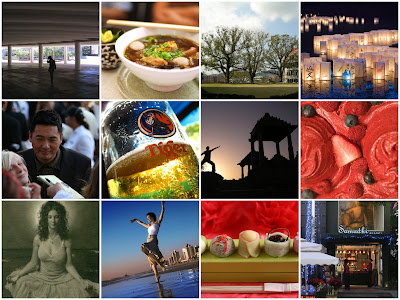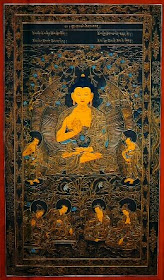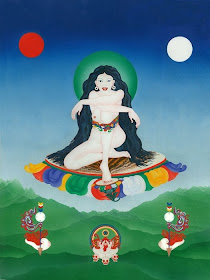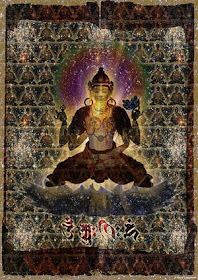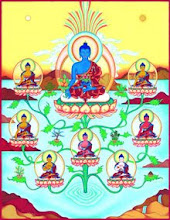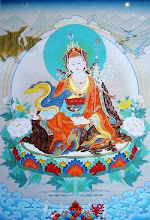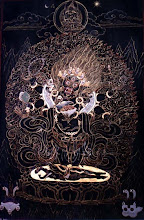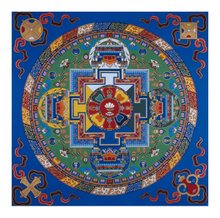While waiting for my dinner to be served, I called Jiwan and found to my regret that he was leaving the next day. Having just unpacked and being worn out from the long trip to Kathmandu, I wished him well. I didn't want to have to repack and make the less than relaxing trip out to the village of Thanguan. But as I ate my dinner I began to reconsider. Here was an excellent opportunity to spend a week doing intensive painting practice under the personal guidance of a skilled painter, an opportunity that is perhaps not granted often or to many. I would, I thought, be very foolish to pass it up. And so after dinner I called and told Jiwan that if he wouldn't mind having me along, I would very much like to go with him. We agreed to put off our departure for one day and left the following afternoon after lunch at Jiwan's home in Bhaktapur.
Assuming Jiwan would have finished the painting during the six months since I had left Nepal, I never imagined I'd see Thanguan again. Returning felt like something of a homecoming, seeing again the place where I established some small confidence in my drawing abilities. I will always remember that week of work, that small country temple, and my colleagues very fondly.

Everything was much the same as I had left it, except that at the end of summer life was evident in the plants, flowers, and abundant insect population. There was much more color than in February, and much more sound, from the buzzing of bees, the humming of flies and dragonflies, the chirping of cicadas and crickets, and the clicking and clacking of geckos. Heavy showers and cold winds blew in on short notice, and the precipitation left more than one rainbow and some incredible sunsets.






In the temple, Jiwan had finished most of the sketching and was now ready to start painting. In fact he had already started and our first task was completing the banner of protective deities that circled the uppermost part of the three walls that we were to work on. We began by finishing the clouds at the very top of the banner. Using a stencil and black chalk, we outlined the clouds, penciled on top of and then wiped off the chalk, and afterwards painted on top of the pencil in a shade lighter than the background. This was then outlined in white. We next went around all three walls and added a shiny gold paint to the deities, filled in their eyes, and completed a few other finishing touches before covering the whole thing in varnish, which would seal the paint and provide a cleanable finish. This occupied two days.



On the third we set out to paint the sky wrapping around all three walls, the background to the large deities and mandalas. This is, as Jiwan said, one of the most difficult jobs of the entire project. It requires not only that the painter be able to skillfully blend shades, but also to do so quickly, as the blending process takes place while the paint is still wet through short bursts of rapid arm movement. The work has to be completed in segments, which adds the additional difficulty of matching each segment to the previous. I've done a little bit of this on paper, but the scale involved is a completely different experience. Jiwan allowed me to do the first coat, after which he applied a much more refined finish.


This was finished by lunch, after which we started working on individual deities. I began by painting the landscape, a process similar to the sky but much simpler as it requires only two colors, light green and white. I got this far before I was overtaken by a fit of sneezing. My throat became raw and I could no longer breath through my nose. Jiwan had throughout the past three days been sneezing now and then, was also having trouble breathing and had a scratchy throat. This was, he said, a reaction to the paint, one he previously experienced. It finally caught up with me on this third day. I sat outside for a while to relax and recuperate and during that time a couple of other painters from the village stopped by to lend a hand. Both were, Jiwan said, thangka painters with little experience painting temples, explaining perhaps why they didn't stay long. Once they left I went back in and started working on shading rocks and lining leaves in the trees, but was again overcome by sneezing and so left off work for the rest of the afternoon.

That night I slept poorly. I couldn't breathe except through my mouth, my throat was raw, and I developed a hacking cough. Most mornings I am up before sunrise, but this morning I wanted nothing more than to sleep. There also something of a dilemma about what to do. It seems my reaction was caused by the paint. I couldn't be 100% sure of that. Thanguan, like most of Nepal, is a dusty place and that could just as easily have set me off. But usually sneezing caused by dust is intermittent, passes quickly and doesn't cause a sore throat. As Jiwan was experiencing much the same and has had similar experiences he attributes to paint, the best guess is that it was in fact the paint. And if that was so, I didn't see how I could go back to painting without some serious protective gear. It would be like roulette, waiting for the same thing to happen again, with possibly worse results than the first episode. But calling off the work so soon after we had arrived seemed so disappointing, especially as Jiwan had rearranged his schedule and as it is not so easy getting to Thanguan.
I explained all this to Jiwan and without a second thought he offered to take me back to Kathmandu that very morning. But as I was so tired and worn out from a restless night, I really didn't feel much like the 90 minute hike down the mountain and the crowded, bouncing three-hour bus ride. We agreed that we would stay the day. Jiwan could do a little more work and I could rest up for the journey back. I spent the day sleeping, reading, and listening to music, and the next morning after tea we started off down the mountain.
My sinuses have been fine since. No more sneezing, sore throat or cough. But I have been greatly disappointed in having to give up the work so soon and to have put Jiwan to such inconvenience. It seems that if I ever want to such work again I'm going to have to invest in some protective gear, including a mask, goggles, and gloves. If there are any painters reading this with suggestions for particular types or brand of gear, I'd be very happy to hear from you.

From tomorrow, it's back to the classroom. Though perhaps not for long. On the way to the internet cafe where I am posting this, I ran into a classmate who told me all of next week is a school holiday! When I looked incredulous, he insisted I ask at the office, as if I couldn't believe him. I can. I just don't want to.
#





















